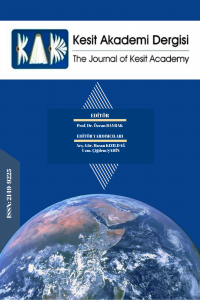GERÇEK BİR YAŞAM OLAYINA DAYALI YENİ PSİKOLOJİK DIŞLANMA PARADİGMASININ ETKİLİLİĞİ
vinyet, yeni psikolojik dışlanma paradigması, ihtiyaç tehdidi, dışlanmış bireyler
THE EFFECTIVENESS OF THE NEW PSYCHOLOGICAL EXCLUSION PARADIGM BASED ON A REAL-LIFE EVENT
vignette, new ostracism paradigm, need threat, ostracized individuals,
___
- Abayhan, Y., ve Aydın, O. (2014). Sosyal etki kuramı bağlamında psikolojik dışlanma: Dışlayan ve dışlanan grup üyesi sayısının temel ihtiyaçlara yönelik tehdit algısı üzerindeki et- kisi. Türk Psikoloji Dergisi, 29(73), 108-121.
- Amabile, T. M. (1983). The social psychology of creativity: A componential conceptualization. Journal of personality and social psychology, 45(2), 357.
- Aydın, O., Şahin, D., Yavuz Güzel, H., Abayhan, Y., Kaya, A. G., ve Ceylan, S. (2013). Ait olma ihtiyacının ve haberdar olmanın psikolojik dışlanmaya gösterilen tepkiler üzerindeki etkileri. Türk Psikoloji Dergisi, 28(72), 21-31.
- Baumeister, R. F., ve Leary, M. R. (1995). The need to belong: desire for interpersonal attachments as a fundamental human motivation. Psychological Bulletin, 117(3), 497.
- Baumeister, R. F., ve Tice, D. M. (1990). Point-counterpoints: Anxiety and social exclusion. Journal of Social and Clinical Psychology, 9(2), 165-195.
- Cohen, J. (1988). Statistical power analysis for the behavioral sciences, 2nd ed. Hillsdale, NJ: Erlbaum.
- Goodall, J. (1986). Social rejection, exclusion, and shunning among the Gombe chimpanzees. Ethology and Sociobiology, 7, 227-236.
- Gruter, M., and Masters, R.D. (1986). Ostracism as a social and biological phenomenon: An introduction. Ethology and Sociobiology, 7, 149-158.
- Hartgerink, C. H., Van Beest, I., Wicherts, J. M., ve Williams, K. D. (2015). The ordinal effects of ostracism: A meta-analysis of 120 Cyberball studies. PloS one, 10(5), e0127002.
- Lancaster, J. B. (1986). Primate social behavior and ostracism. Ethology and Sociobiology, 7, 215- 225.
- Ren, D., Hales, A. H., & Williams, K. D. (2017). Ostracism: Being ignored and excluded. In K. D. Williams, & S. A. Nida (Eds.), Ostracism, exclusion, and rejection (pp. 10-28). Routledge.
- Tabachnick, B. G., & Fidell, L. S. (2013). Using multivariate statistics: International edition. Pearson2012.
- Twenge, J.M., Baumeister, R.F., Tice, D.M.,ve Stucke, T.S. (2001) If you can’t join them, beat them: effects of social exclusion on aggressive behavior. Journal of Personality and Social Psychology,81, 1058–1069.
- Van Beest, I, ve Williams, K.D. (2006). When inclusion costs and ostracism pays, ostracism still hurts. Journal of Personality and Social Psychology, 91(5), 918-928.
- Wesselmann, E. D., Butler, F. A., Williams, K. D., & Pickett, C. L. (2010). Adding injury to insult: Unexpected rejection leads to more aggressive responses. Aggressive Behavior, 36(4), 232-237.
- Williams, K. D., Cheung, C. K., ve Choi, W. (2000). Cyberostracism: effects of being ignored over the Internet. Journal of Personality and Social Psychology, 79(5), 748.
- Williams, K.D. (2007a). Ostracism. Annual Review of Psychology, 58, 425-452.
- Williams, K.D., ve Zadro, L. (2005). Ostracism: The indiscriminate early detection system. K.D. Williams, J.P. Forgas ve W.V. Hippel (Eds). The social outcast: Ostracism, social exclusion, rejection, and bullying içinde (s. 19- 33). New York: Psychology Press.
- Wolf, W., Levordashka, A., Ruff, J. R., Kraaijeveld, S., Lueckmann, J. M., & Williams, K. D. (2015). Ostracism Online: A social media ostracism paradigm. Behavior Research Methods, 47(2), 361-373.
- Zadro, L., Williams, K. D., & Richardson, R. (2005). Riding the ‘O’train: Comparing the effects of ostracism and verbal dispute on targets and sources. Group Processes & Intergroup Relations, 8(2), 125-143.
- Başlangıç: 2015
- Yayıncı: Asos Eğitim Bilişim Danışmanlık San. Tic. Ltd. Şti.
ANADOLU BEDESTENLERİNİN MEVCUT DURUMLARI ÜZERİNE BİR İNCELEME
Ruşen ERGÜN, Hicran Hanım HALAÇ
GERÇEK BİR YAŞAM OLAYINA DAYALI YENİ PSİKOLOJİK DIŞLANMA PARADİGMASININ ETKİLİLİĞİ
Hamit COŞKUN, Yasemin ABAYHAN, Hayal YAVUZ GÜZEL, Ayşe TUNA, Mehmet Can SEVİNÇLİ
KIRILGAN BEŞLİ ÜLKELERİNDE FİNANSAL YAKINSAMANIN BİRİM KÖK TESTLERİ İLE ANALİZİ
Yavuz ÖZEK, Halil Oğuzhan ERGÜR
BİR TÂUN ŞEHİDİ ŞEYH İSMAİL SİRÂCEDDÎN ŞİRVÂNÎ VE HAKKINDA YAZILAN ŞİİRLER
“TÜRKİYE TÜRKÇESİ I SESBİLGİSİ” ADLI ESERE DAİR
NOGAY TÜRKLERİNİN MAMAY DESTANI’NA GENEL BİR BAKIŞ
YUNANCADAKİ TÜRKİZMLER ÜZERİNE YAPILAN ÇALIŞMALARA BİR ÇERÇEVE, DEĞERLENDİRME VE KAYNAKÇA DENEMESİ
ÖĞRENCİLER TÜRKİYE'DE BİYOETİK SORUNLARI VE BİYOETİK EĞİTİMİ HAKKINDA NE DÜŞÜNMEKTEDİRLER?
Gülbin ÖZKAN, Hayriye ZENGİN TEPEKUYU, Ünsal UMDU TOPSAKAL
DEMOKRAT PARTİ BÜTÇE GÖRÜŞMELERİNDE TÜRK ORDUSU HAKKINDAKİ TARTIŞMALAR
